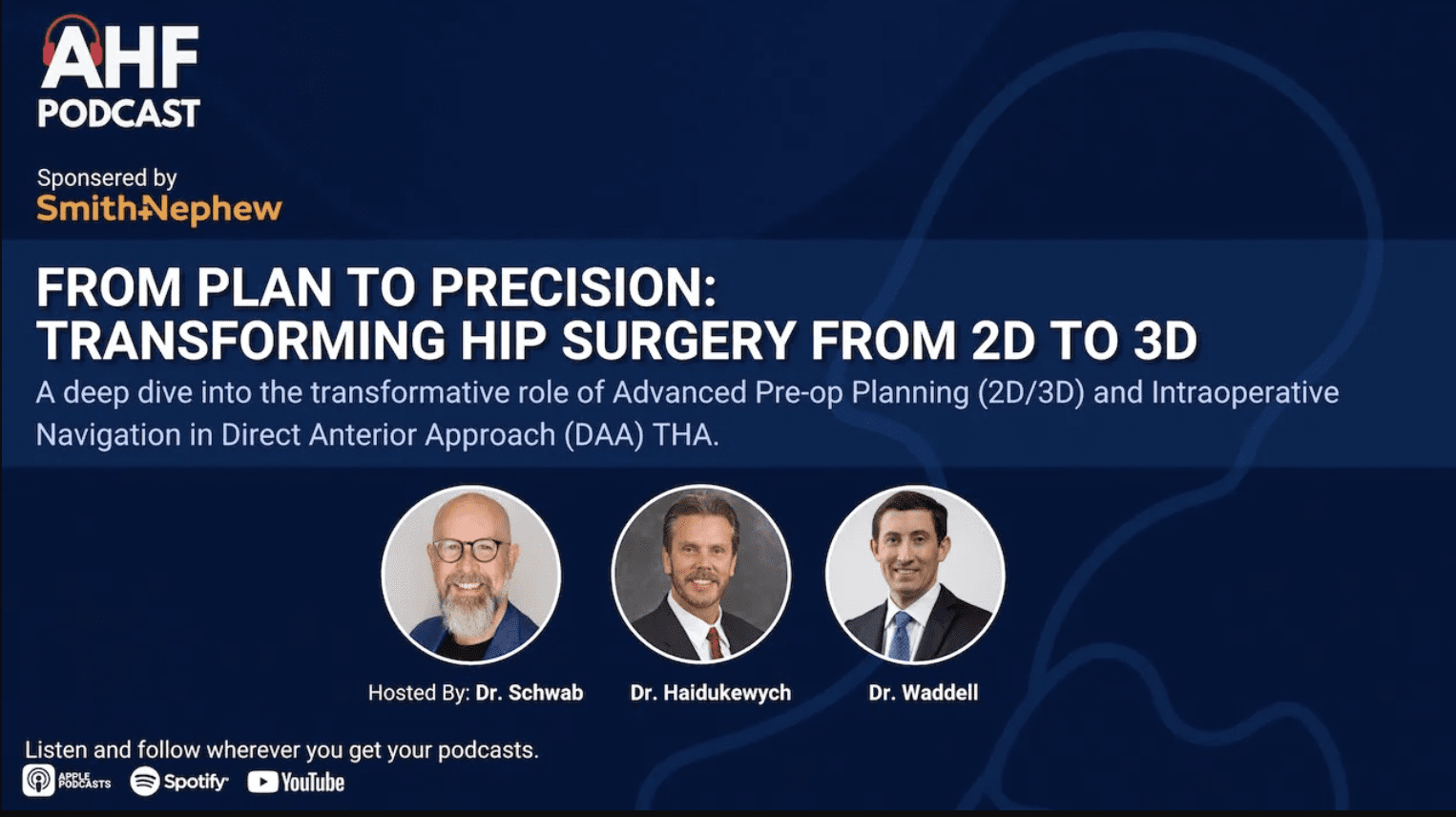Anterior Approach Acetabular Revisions
– This is the fourth lecture in our series – where Dr. Jonathan Yerasimides discusses acetabular revisions from an anterior approach.
Lecture 3 covered some of the valuable information you can derive from a standard AP pelvis X-ray. When it comes to identifying acetabular defects to plan revisions – you can also make some very good assumptions by interpreting the displacement of the cup on an X-ray because this occurs in very consistent patterns. For example:-
Cavitary defects – the cup displacement on a cavitary defect of the acetabulum will usually be non-displaced or displaced directly superiorly. If you see a direct superior migration of the cup on the AP pelvis view where it has not moved laterally or medially, you can assume the walls and columns are going to be intact. If the iliopectineal line is intact, you know the cup hasn’t displaced through the anterior column.
When that iliopectoneal line is displaced, you know your anterior column is disrupted – it is extremely rare for a posterior column defect to have an ilio-ischial line displacement so don’t get tricked if you see the cup moving medially.
With a Posterior defect, the AP pelvis will show what we call “up and out” displacement – where the cup displaces superiorly AND laterally. To address these, Dr. Yerasimides will usually use a posterior approach as this makes it easier to put in an augment, particularly in cases where a previous augment has failed, or with complex Paprosky 3A up and out defects.
An “up and in” defect – a protrusio defect – is when the cup is displaced towards the inner table of the pelvis (Paprosky 3B). The AP pelvis view indicates that there will be a defect of the anterior wall, the anterior column and the quadrilateral surface. It is also possible to predict with reasonable certainty that the posterior column and posterior wall will be intact. This type of anterior only defect can be treated extremely effectively from an anterior approach. A posterior approach surgeon would typically use a cup and cage construct or a custom tri-flange device for the reconstruction but as you get more comfortable with the anterior approach you learn how to treat this from a direct anterior exposure and add appropriate augments. This approach is arguably superior as it enables bone ongrowth or ingrowth instead of spanning the defect.
Fluoroscopy in anterior approach acetabular revisions
Dr. Yerasimides also uses intraoperative fluoroscopy to ensure appropriate positioning – for example, to ensure that the hip center of rotation is brought back to where it should be following a superiorly migrated cup. Fluoroscopy ensures that you have an accurate depiction of the anteversion, abduction angle and if the cup is fully seated against bone. You can also check your screw position as the accuracy of placement is not affected by having poor visual landmarks due to the defect. Dr. Yerasimideas describes a complex Proprosky 3B defect case – where the entire cup was displaced into the inner table of the pelvis. Anterior Acetabular Cup revision video Dr. Yerasimides narrates a step-by-step video that covers the revision of a cup – in this case, one that needed to be revised due to metallosis, osteolysis and pain typical of a metal-on-metal hip.
Key points for DAA Revision of the Acetabulum
– Electrocautery dissection if index surgery was DAA due to scar tissue
– Excise inner half of capsule/ scar to debulk for exposure including release of entire medial capsule from the femur
– Excise capsule/ scar over anterior rim of acetabulum to allow placement of the anterior retractor (the key retractor)
– Minimize release of the inside of the trochanter and posterior femur – this may require disengaging the femoral head into the acetabulum
Externally rotate the leg to rest trunnion lateral to the acetabulum.
Also covered are tips and tricks for dislocation, removal of the head, the use of explant tools to remove even well-fixed cups with minimal bone loss, and the use of fluoroscopy.
Final thoughts:
Note that, in revision surgery, 75 percent of your time is spent on dissection and exposure, and only 25 percent is spent taking implants out putting implants in. If your exposure is excellent – then the actual replacement of the components will be far easier.
For further reading: From Anterior Hip Replacement: From Origin to Current Advanced Techniques edited by Joel M. Matta, Alexander P. Sah Complex Acetabular Reconstruction using the Anterior Approach The Extended Direct Anterior Approach for Column Augmentation in the Deficient Pelvis: A Novel Surgical Technique, and Case Series Report Yerasimides JG. “Acetabular Direct Anterior Approach Revision Surgery.” Direct Anterior Approach to Hip Reconstruction, ed Bal BS, Rubin LE, Keggi K, Slack, 2016.






